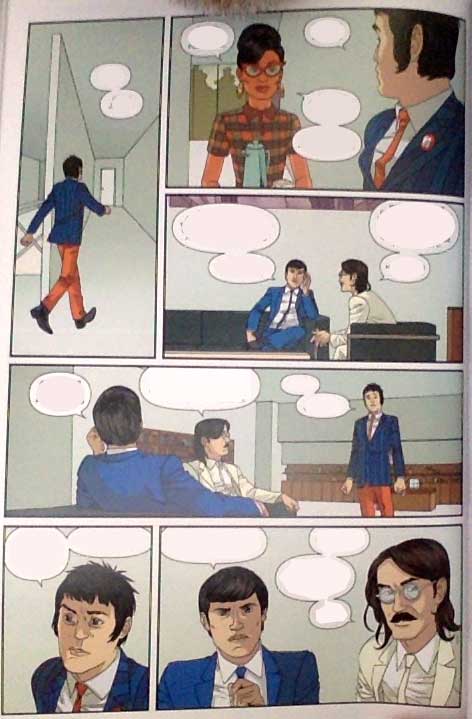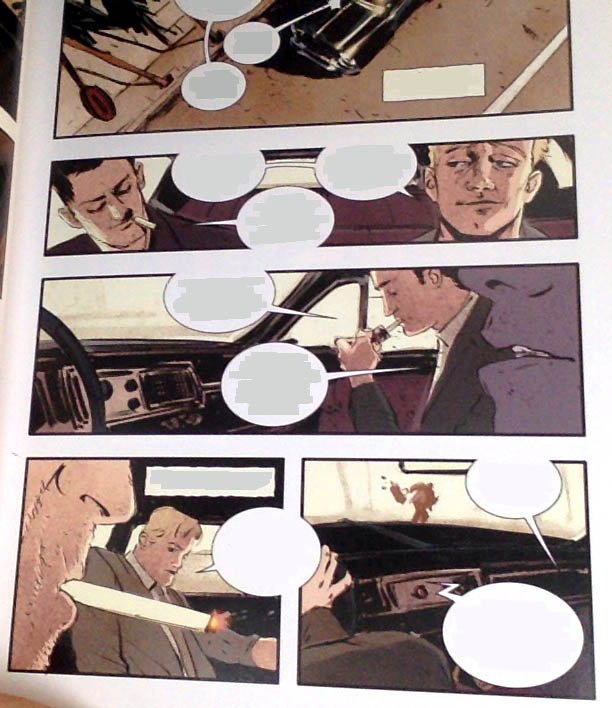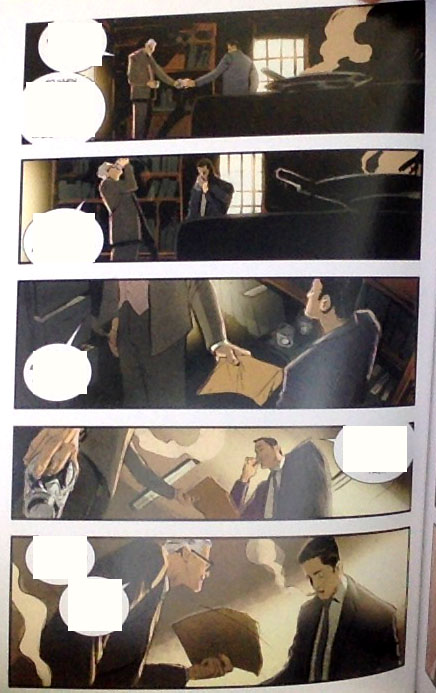Comics are two warriors, Art and Script, fighting back to back against the horde of boredom.
As a writer you must always know what you are trying to say at any given moment to support the narrative and keep the story moving forward. Just as the art must do the same.
Effective comic storytelling taps a fundamental synergy between the two.
Yin and Yang. Always working together, IN BALANCE.
Talking heads break this balance and synergy.
Talking heads are SCRIPT saying to ART;
“Back off man, you’re not needed. I can do both our jobs better alone.”
It’s insulting to Art and it’s insulting to the Reader.
I explain the danger of Talking Heads in the Writer’s Guide to Comics… I’ve been preaching against them for years… Hopefully, this article will once and for all put it to rest, there is a better way.
Before I break it down in comic pages, let’s define it.
TALKING HEADS are panels focused on characters doing nothing but talking.
OK, let’s throw Image’s Nowhere Men under the bus. Vroooom Vrooom.
Take a look at this page and tell me what the graphic novel story is about. Hell, tell me what the scene is about.
And that folks is why talking heads kill comics.
Synergy broken.
Art is sitting on a bench smoking a cigarette, while Script dual wields long swords, cutting boredom zombies left and right, but getting nowhere (Nowhere Men, see what I did there).
Sure, you can make something up in answer to my question above the Nowhere Men sample, you could say these cats are waiting to finish a big corporate merger… or they are ant scientists about to purchase a new queen for their ant farm.
Point is, you have no idea, because the Art has left the building, leaving his part of narrative storytelling to Script and his arrangement of 26 letters.
Still not convinced?
Let’s do it again… Boom’s Hit 1955.
This is not a real Talking Heads page, because we have an initial establishing shot and a final panel showing some action… BUT if we only focus in on panels 2-4… again I ask, WTF is going on in this story right here?
Now here’s the truth about Talking Heads;
Stories are mostly about… PEOPLE… so of course, there are going to be times when the story needs you to focus in on those people alone. When the drama of the story requires Script to step out in front of Art against the zombie horde and cut a path for Art to follow.
But whenever you do this, you have literally, just lit a fuse and are holding a bomb. GET RID OF THE BOMB AS SOON AS YOU CAN. If you hold that bomb to long, it will explode and kill your comic.
Let’s take another look at Carlson and Del Rey’s Hit 1955.
We’ve got a full page of basically, two people standing around talking… but HMMMM, this time there’s something different. Art has NOT left the building. I’ll ask again, what can you tell me about the story here by the art alone.
I’ll tell you what I see.
1) That’s not cola they’re sharing. Hmmm, when do two men share a hard drink? Something serious or important must be going on.
2) That folder looks important.
3) Smoking guy doesn’t like the looks of that folder. He’s hesitant to take it. And grey haired guy didn’t just sip his liquor, he killed it. Whatever’s in that folder must be bothering him.
4) Whatever that folder’s about, grey hair seems agitated and smoking guy is really trying to keep his distance.
Narratively, there’s not a TON of visual information being conveyed, without context I really don’t know what’s going on, though I have some clues. BUT once the Script comes into play, suddenly there is an explosion of Synergy with Art and Script working together… Turning a potentially dead Talking Heads page into an effective page.
Sticking a Band-Aid On Doesn’t Make Wounds Go Away
Look at the beautiful Comictography throughout that last page.
Distracting and stimulating the reader like this definitely helps.
As I go over in the Writer’s Guide, if you hit the 4 essential elements to EVERY comic panel, you CAN compensate…
- Emotion
- Comictography
- Mise-en-scene
- Movement
For a while, but have no delusions, no matter how you package it, I assure you, the bomb fuse has been lit.
Nobody wants to spend 22 pages looking at similar page breakdowns.
But it worked for Famous Comic…
Sure, in the 100 or so years comics have been around, in the millions of books that have been published, there have been a handful of books that deliver Talking Heads and find success.
First, the audience and fans for those books, were so in love with the story/script, they probably would have supported the books in straight prose. Their brains were detached from the art.
Second, what about all the books that have tried all (or mostly) Talking Heads and died a horrible death. Why would you follow the path of the super-ultra-hyper-minority, who pulled off a miracle and ignore all the guys who crashed and burned? That’s bad science.
Third, you’re not them.
I could draw really bad all day all night. I ain’t never gonna be Picasso. That was his life, his journey.
You my friend, ain’t Picasso either.
You may very well soar to greater heights than Picasso, but it will be in your own way and time.
I want you to strike, “But it worked for Famous Comic” from your vocabulary. I encounter this a lot when working with newer writer/creators.
Never fall back on that phrase again. For anything. (Not just Talking Heads.)
It’s a negative, misleading approach to reaching your full potential.
You don’t want none of the ginger bread house those breadcrumbs lead to. Find your own forest, follow your own crumbs, and a house made out of something we’ve never seen before.▪
About the Author —
Nick Macari is a full-time freelance story consultant, developmental editor and writer, working primarily in the independent gaming and comic markets. His first published comic appeared on shelves via Diamond in the late 90’s. Today you can find his comic work on comixology, amazon and in select stores around the U.S. Visit NickMacari.com for social media contacts and news on his latest releases.
** Pages from Image and Boom copyright their respective owners, showcased here under Fair Use for educational purposes. **




